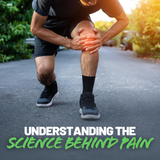Understanding The Science Behind Pain
Pain is a universal indicator that a majority of people encounter, but what is the science behind pain and how does or body process these discomforting alerts. Pain, often perceived as just an unpleasant sensation, is actually a complex and crucial biological signal. It's an integral part of our survival mechanism, deeply connected to our well-being. This article delves into the science behind pain and explores how STAMINAPRO products leverage this understanding to offer effective pain and inflammation reduction.
The Intricate Science of Pain: A Biological and Neurological Journey
Understanding the science behind pain involves unraveling a series of biological and neurological events including transduction, transmission, modulation, and perception.
- Transduction
- This is the initial step where harmful stimuli (like injury or inflammation) are converted into electrical signals.
- Nociceptors, specialized sensory receptors, detect these harmful stimuli.
- These receptors are activated by various factors, such as extreme temperatures, physical damage, or chemical changes.
- Transmission
- The electrical signals generated during transduction are carried from the nociceptors to the spinal cord and then to the brain.
- This involves the movement of signals along nerve fibers, specifically A-delta and C fibers.
- A-delta fibers transmit fast, sharp pain, while C fibers carry slower, dull, and throbbing pain.
- Modulation
- At this stage, the pain signals can be either amplified or dampened before they reach the brain.
- This modulation can occur both in the spinal cord and along the pathway to the brain.
- The body releases natural pain-relieving chemicals, like endorphins, which can inhibit pain transmission, reducing the perception of pain.
- Perception
- This is the final stage where the brain interprets these signals as pain.
- Multiple areas of the brain are involved, including the thalamus, somatosensory cortex, and limbic system.
- The process integrates both the physical sensation of pain and its emotional aspects, like discomfort and distress.
Each of these stages plays a crucial role in how we experience pain, from the initial injury to the complex processing in the brain, culminating in the perception of pain as a protective mechanism.
Image Source: Sharma, R. S., & Das, G. (2018). What is the minimum knowledge of pain medicine needed for other specialty?. What is the Minimum Knowledge of Pain Medicine needed for Other Specialty?
Cognitive and Emotional Influences on Pain
Pain isn't just a physical experience; it’s heavily influenced by cognitive and emotional factors. How one focuses on their pain can significantly affect its intensity. The degree of attention given to pain significantly impacts its perception. When an individual focuses intently on their pain, it can intensify the experience. Conversely, distraction or focusing on other tasks can reduce the perception of pain. This involves how an individual interprets or understands their pain. Personal beliefs, past experiences, and knowledge about the pain or its cause all play a role. For instance, pain perceived as a sign of serious illness may be more distressing than pain believed to be a minor, temporary condition.
Additionally, emotional reactions like anxiety or depression can exacerbate pain, making its management complex and multifaceted. These emotions can amplify the experience of pain. For example, anxiety may increase muscle tension, which can exacerbate pain sensations. Emotional states can trigger physiological responses, like increased heart rate and muscle tension, which can further enhance pain perception.
Chronic Pain and Neuroplasticity
Chronic pain is linked to neuroplastic changes in the brain, which involves alterations in the structure and function of neural pathways and regions involved in pain processing. These changes lead to an increased sensitivity to pain signals. This heightened sensitivity can make the brain more alert to pain, even in the absence of typical stimuli, complicating chronic pain conditions. Additionally, chronic pain can affect areas of the brain responsible for mood, leading to increased risk of conditions like depression and anxiety.
Image Source: Dunleavy, K., Puentedura, E. L., Spielholz, N. I., & Cheng, M. S. (2014). (PDF) the role of associative learning and fear in the development of ... The role of associative learning and fear in the development of chronic pain – a comparison of chronic pain and post-traumatic stress disorder.
Inflammation’s Pivotal Role in Pain
Inflammation plays a significant role in pain. When tissues are damaged, inflammatory mediators are released, making nociceptors more responsive and increasing the perception of pain, a condition known as hyperalgesia. Inflammation can also contribute to the persistence of pain, increasing the chances of developing chronic pain conditions.
STAMINAPRO’s Approach to Pain Management
By using the understanding of the science behind pain, STAMINAPRO products are uniquely formulated to interact with the body’s complex pain pathways:
- Clinically-Proven Effects: STAMINAPRO patches have been clinically-proven to reduce pain and inflammation in the body within just 15 minutes of application. Furthermore, it was found that patients experienced a nearly 40% reduction in pain on average!
- Targeting Inflammation: Given the crucial link between inflammation and pain, STAMINAPRO patches focus on managing inflammation by emitting energy patterns that correspond to anti-inflammatory substances, effectively reducing inflammation and associated pain.
- Non-Invasive, Chemical-Free Solution: Offering a non-invasive and medication-free option, STAMINAPRO is ideal for those looking for natural pain management solutions.
- Holistic Approach to Pain Management: These patches can be integrated into a comprehensive pain management plan, complementing other methods like physical therapy, exercise, and stress reduction.
- Ease of Use and Convenience: Designed for user-friendliness, STAMINAPRO patches are easy to apply and can be worn discreetly, providing continuous pain relief suitable for active lifestyles.
Pain, with its multifaceted nature, requires a comprehensive approach to management. STAMINAPRO taps into the complexity of the science behind pain to provide a novel, effective solution for pain relief. By addressing the multiple dimensions of pain, STAMINAPRO offers a promising path for those seeking relief from both acute and chronic pain.
Experience a new era in pain management with STAMINAPRO, where advanced science meets natural recovery.









